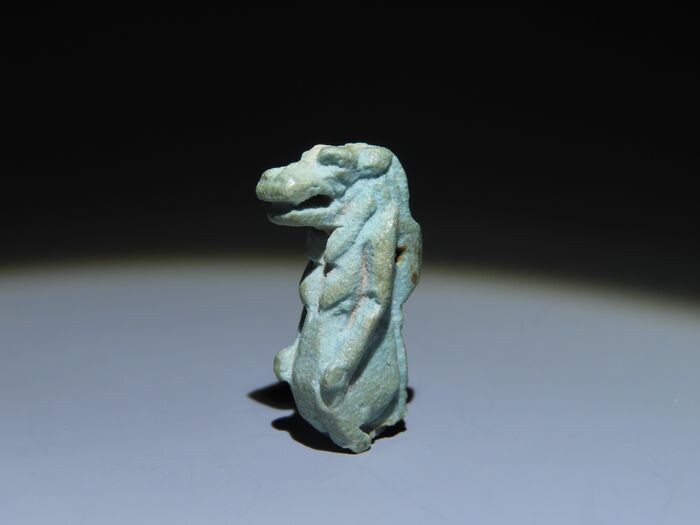Ancient Egyptian Faience Amulet of the Goddess Tawaret (Toeris). H: 25 mm. Very fine sculpture
Amulet of the Goddess Tawaret (Toeris) Ancient Egyptian Late Period, 664 - 323 BC Faience Height 25 mm CONDITION: Fragment in Good Condition PROVENANCE: Private collection, Brest (France) , 1970 - 1980. DOCUMENTS: Provided of export license issued by the Ministy of Culture. DESCRIPTION: Taweret and other closely related goddesses were created from a blending of lion, hippo, crocodile, and human attributes. The three animals were some of the fiercest species found in ancient Egypt and combining their strengths produced a most potent deity and therefore amulet. Taweret's particular responsibility was the protection of women during pregnancy and childbirth. She is often portrayed leaning on a sa symbol. Her representation was sometimes used on tomb walls or funerary equipment to protect the deceased during rebirth. Amulets in Ancient Egypt were both decorative and practical, as they were considered as having apotropaic powers to protect or bestow power upon the wearer. Not only worn by the living, amulets have been found inside the wrappings of mummies, as they were used to prepare the deceased for the afterlife. Amulets held different meanings, depending on their type or form. Small amulets depicting gods and goddesses seem to have induced the protective powers of the deity. On the other hand, small representations of anatomical features or creatures suggest that the wearer required protection over a specific body part, or that he/she desired the skills of a particular animal. Amulets depicting animals were very common in the Old Kingdom Period, whilst representations of deities gained popularity in the Middle Kingdom. Notes: - The piece includes authenticity certificate. - The piece includes Spanish Export License (Passport for European Union) . - The seller guarantees that he acquired this piece according to all national and international laws related to the ownership of cultural property. Provenance statement seen by Catawiki.
[ translate ]View it on
Estimate
Time, Location
Auction House
Amulet of the Goddess Tawaret (Toeris) Ancient Egyptian Late Period, 664 - 323 BC Faience Height 25 mm CONDITION: Fragment in Good Condition PROVENANCE: Private collection, Brest (France) , 1970 - 1980. DOCUMENTS: Provided of export license issued by the Ministy of Culture. DESCRIPTION: Taweret and other closely related goddesses were created from a blending of lion, hippo, crocodile, and human attributes. The three animals were some of the fiercest species found in ancient Egypt and combining their strengths produced a most potent deity and therefore amulet. Taweret's particular responsibility was the protection of women during pregnancy and childbirth. She is often portrayed leaning on a sa symbol. Her representation was sometimes used on tomb walls or funerary equipment to protect the deceased during rebirth. Amulets in Ancient Egypt were both decorative and practical, as they were considered as having apotropaic powers to protect or bestow power upon the wearer. Not only worn by the living, amulets have been found inside the wrappings of mummies, as they were used to prepare the deceased for the afterlife. Amulets held different meanings, depending on their type or form. Small amulets depicting gods and goddesses seem to have induced the protective powers of the deity. On the other hand, small representations of anatomical features or creatures suggest that the wearer required protection over a specific body part, or that he/she desired the skills of a particular animal. Amulets depicting animals were very common in the Old Kingdom Period, whilst representations of deities gained popularity in the Middle Kingdom. Notes: - The piece includes authenticity certificate. - The piece includes Spanish Export License (Passport for European Union) . - The seller guarantees that he acquired this piece according to all national and international laws related to the ownership of cultural property. Provenance statement seen by Catawiki.
[ translate ]


